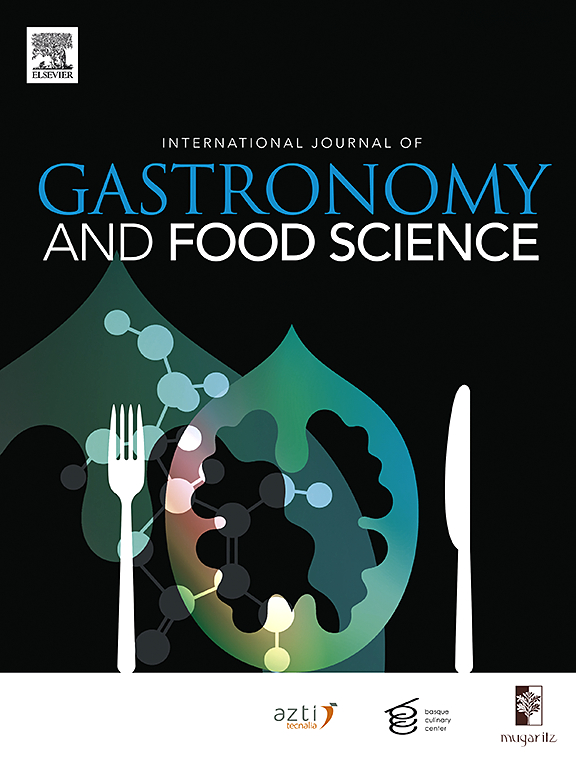Different legumes aquafaba as a plant-based egg white substitute in baked and non-baked French meringues
IF 3.6
2区 农林科学
Q2 FOOD SCIENCE & TECHNOLOGY
International Journal of Gastronomy and Food Science
Pub Date : 2025-09-16
DOI:10.1016/j.ijgfs.2025.101302
引用次数: 0
Abstract
Background
French meringue, prepared by beating egg whites with sugar, is widely used in confectionery. However, there is a growing demand for egg-free products due to allergies/sensitivities or vegan diets. The most commonly used egg white substitute in foaming is aquafaba, the liquid obtained from cooking legumes. However, there is a lack of studies evaluating aquafabas from different legumes and their characteristics for foaming meringues.
Aim
This study evaluated the physicochemical and functional properties of meringue made with aquafaba from chickpeas, soybeans, lentils, peas, and pinto beans.
Method
The study was divided into the following stages: preparation of aquafaba (12 h soaking, pressure-cooking and refrigeration of the cooked grain in cooking water/24 h); quantification of aquafaba total proteins; determination of the maximum beating time and overrun; determination of the meringue stability before baking; determination of the raw and baked meringues’ moisture content.
Results
There was no significant difference in aquafaba's protein content, except for lentils, which had a higher protein content. Aquafabas from peas (25 %) and chickpeas (20 %) presented the greatest overrun, while soybeans had the lowest (5 %). There was no significant difference between the samples regarding stability (p < 0.4798). After baking, the pinto bean aquafaba meringue exhibited the most significant loss of moisture (91.94 %), followed by peas (90.73 %), lentils (90.52 %), chickpeas (88.88 %), and soybeans (84.31 %).
Conclusion
Meringues produced with pea and chickpea aquafaba are more promising. Although pea and chickpea aquafabas did not present the highest protein content, other factors, such as stability and moisture loss, were crucial for meringue characteristics.
不同的豆科植物aquafaba作为一种植物性蛋白替代品,用于烘焙和非烘焙法式蛋白派
法国蛋白霜是由蛋白和糖混合制成的,广泛用于糖果行业。然而,由于过敏/敏感或纯素饮食,对无蛋产品的需求不断增长。最常用的蛋清替代品是aquafaba,一种从烹饪豆类中获得的液体。然而,对不同豆科植物的水合蛋白及其用于发泡蛋白霜的特性进行评价的研究较少。目的研究以鹰嘴豆、大豆、扁豆、豌豆和扁豆为原料制备蛋白霜的理化性质和功能特性。方法研究分为以下几个阶段:制备水煮液(浸泡12 h,加压蒸煮,蒸煮后将煮熟的谷物放入蒸煮水中冷藏/24 h);aquafaba总蛋白定量;最大跳动时间和超限的确定;烘焙前蛋白霜稳定性的测定生蛋白酥和烤蛋白酥水分含量的测定。结果除小扁豆蛋白质含量较高外,各品种间蛋白质含量无显著差异。来自豌豆(25%)和鹰嘴豆(20%)的Aquafabas出现了最大的泛滥,而大豆的泛滥率最低(5%)。两种样品在稳定性方面无显著差异(p < 0.4798)。烘烤后,平豆水法蛋白霜水分损失最大(91.94%),其次是豌豆(90.73%)、小扁豆(90.52%)、鹰嘴豆(88.88%)和大豆(84.31%)。结论以豌豆和鹰嘴豆水豆粕为原料制备蛋白霜具有较好的应用前景。虽然豌豆和鹰嘴豆水乳蛋白的蛋白质含量不是最高的,但其他因素,如稳定性和水分损失,对蛋白蛋白的特性至关重要。
本文章由计算机程序翻译,如有差异,请以英文原文为准。
求助全文
约1分钟内获得全文
求助全文
来源期刊

International Journal of Gastronomy and Food Science
Social Sciences-Cultural Studies
CiteScore
5.30
自引率
10.50%
发文量
170
审稿时长
45 days
期刊介绍:
International Journal of Gastronomy and Food Science is a peer-reviewed journal that explicitly focuses on the interface of food science and gastronomy. Articles focusing only on food science will not be considered. This journal equally encourages both scientists and chefs to publish original scientific papers, review articles and original culinary works. We seek articles with clear evidence of this interaction. From a scientific perspective, this publication aims to become the home for research from the whole community of food science and gastronomy.
IJGFS explores all aspects related to the growing field of the interaction of gastronomy and food science, in areas such as food chemistry, food technology and culinary techniques, food microbiology, genetics, sensory science, neuroscience, psychology, culinary concepts, culinary trends, and gastronomic experience (all the elements that contribute to the appreciation and enjoyment of the meal. Also relevant is research on science-based educational programs in gastronomy, anthropology, gastronomic history and food sociology. All these areas of knowledge are crucial to gastronomy, as they contribute to a better understanding of this broad term and its practical implications for science and society.
 求助内容:
求助内容: 应助结果提醒方式:
应助结果提醒方式:


